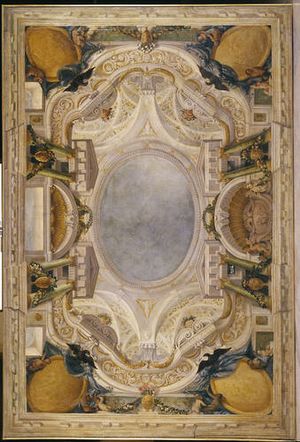Agostino Mitelli facts for kids
Agostino Mitelli (born March 16, 1609 – died August 2, 1660) was a famous Italian painter from the Baroque period. He was especially known for his amazing fresco paintings. These paintings often used a special technique called quadratura. This technique created the illusion of architectural designs that looked real.

Mitelli was born in Battedizzo, a town near Bologna, Italy. He later passed away in Madrid, Spain, while working for King Philip IV of Spain. He learned to paint from teachers like Gabriello Ferrantini and Girolamo Curti.
Working with Michelangelo Colonna
Agostino Mitelli worked closely with another artist named Michelangelo Colonna. They had a very successful partnership for many years. Colonna usually painted the people and figures in the artworks. Mitelli, on the other hand, created the quadratura parts. These were the painted architectural backgrounds that looked like real buildings.
Their amazing quadratura artworks can still be seen in many Italian cities. You can find examples in Bologna, Parma, Modena, Florence, Rome, and Genoa. This shows how popular their unique style was.
In 1658, Colonna and Mitelli even traveled to Madrid, Spain. They helped decorate important royal buildings there. These included the Royal Alcazar and the Palace of Buen Retiro. Mitelli sadly passed away in Madrid. He also created some etchings, which are a type of print, in a book called Freggi dell'architettura da Agostino Mitelli.
His Influence on Art
Agostino Mitelli had many students who learned from him. These students then traveled all over Italy and Europe. Because of them, Mitelli had a big impact on how quadratura painting developed.
His son, Giuseppe Maria Mitelli (1634–1718), also became a painter and engraver. Two of Mitelli's daughters married his students. These students were Baldassare Bianchi, who worked mostly in Mantua, and Giacomo Alboresi, who worked in Parma and Florence. Many other artists were also Mitelli's students, including Giacomo Friani, Domenico Santi, Francesco Quaino, and Andrea Montecelli.
See also
 In Spanish: Agostino Mitelli para niños
In Spanish: Agostino Mitelli para niños

